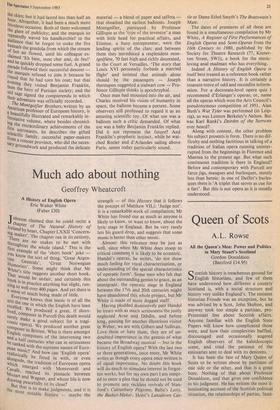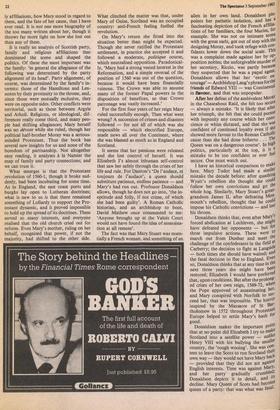Queen of Scots
A.L. Rowse
All the Queen's Men: Power and Politics in Mary Stuart's Scotland Gordon Donaldson (Batsford £14.95) cottish history is treacherous ground for IJEnglish historians, and few of them have understood how different a country Scotland is, with a social structure and history very unlike England's. The eminent historian Froude was an exception, but he was advised by a Scot, John Skelton, and anyway took too simple a partisan, pro- Protestant line about Scottish affairs. Anyone familiar with the English State Papers will know how complicated those were, and how their complexities baffled, discouraged and occasionally angered English observers of the kaleidoscopic scene, and tried the patience of the emissaries sent to deal with its denizens.
It has been the fate of Mary Queen of Scots to be written about by partisans of one side or the other, and that is a great bore. Nothing of that about Professor Donaldson, and that gives one confidence in his judgment. He has written the most il- luminating account of the Scottish political situation, the relationships of parties, farni-
ly affiliations, how Mary stood in regard to them, and the fate of her cause, that I have ever read. It is not one more biography of the too many written about her, though it throws far more light on how she lost out than any of them.
It is really an analysis of Scottish party, family and religious affiliations that dominated the scene and shaped the politics. Of these the most important was the family: 'in general the allegiance of the following was determined by the party alignment of its head'. Party alignment, of course, was determined by the family's in- terests: those of the Hamiltons and Len- noxes by their proximity to the throne, and, since those were mutually exclusive, they were on opposite sides. Other conflicts were territorial, such as those between Argyle and Atholl. Religious, or ideological, dif- ferences really come third, and many peo- ple had shifting allegiances; Mary herself was no devote while she ruled, though her political half-brother Moray was a serious- minded Protestant. Thus the book has several new insights for us and none of the boredom of partisanship. Not altogether easy reading, it analyses a la Namier the map of family and party connections; and we can trust it.
What emerges is that the Protestant revolution of 1560-1, though it broke sud- denly, had been incubating for some time. As in England, the east coast ports and burghs lay open to Lutheran doctrines; what is new to us is that there remained something of Lollardy to support the Pro- testant dynamic, and it proved impossible to hold up the spread of its doctrines. These served so many interests, and everyone realised that the old church cried out for reform. Even Mary's mother, ruling on her behalf, recognised that power, if not the majority, had shifted to the other side. What clinched the matter was that, under Mary of Guise, Scotland was an occupied country: anti-French feeling fuelled the revolution.
On Mary's return she fitted into the situation better than might be expected. Though she never ratified the Protestant settlement, in practice she accepted it and followed a moderate, politique course, which neutralised opposition. Paradoxical- ly, 'Mary had a strong vested interest in the Reformation, and a simple reversal of the position of 1560 was out of the question, because it would have been financially ruinous. The Crown was able to assume many of the former Papal powers in the disposition of benefices, so that Crown patronage was vastly increased.'
For the first four years of her reign Mary ruled successfully enough. Then what went wrong? A succession of crimes and disasters followed — for not all of which was she responsible — which electrified Europe, made news all over the Continent, where she was blamed as much as in England and Scotland.
It seems that her passions were released and she lost control of herself. It was Elizabeth I's almost inhuman self-control that saw her safely through the crises of her life and rule. For Danton's 'De l'audace, et toujours de l'audace', a queen should substitute patience, endless patience — and Mary's had run out. Professor Donaldson allows, though he does not go into, 'the in- eptitude and folly, if not crime, of which she had been guilty'. A Roman Catholic historian, and an archbishop to boot, David Mathew once commented to me: `Anyone brought up at the Valois Court would not have found the idea of assassina- tion at all remote'.
The fact was that Mary Stuart was essen- tially a French woman, and something of an
alien in her own land. Donaldson Phi" points her pathetic isolation, and has a
fascinating depiction of the French affilia- tions of her familiars, the four Maries, for example. She was not on intimate terms with the great earls, got out of step with the
designing Moray, and took refuge with con- fidants lower down the social scale. This
was a complaint made against her by op' position nobles; the unforgivable murder of her secretary, Riccio, was partly because
they suspected that he was a papal agent. Donaldson allows that her 'exotic en' tourage' —Archbishop Lang's phrase forthe friends of Edward VIII — was Continental in flavour, and that was unpopular.
After her defeat of the ambivalent MoraY in the Chaseabout Raid, she felt too secure — always a mistake. `It is likely that after her triumph, she felt that she could pursue with impunity any course which her cons- cience or whim dictated, and that she was confident of continued loyalty even if she showed more favour to the Roman Catholic cause than she had done hitherto . . • The Queen was on a dangerous course'. In high politics, particularly at the top, it is a mistake to be too confident or ever feel secure. One must watch out.
I have an historical comparison to make here. Mary Tudor had made a similar mistake the decade before: after quashing Wyatt's rebellion she thought she could follow her own convictions and go the whole hog. Similarly, Mary Stuart's great- grandson James II, after defeating Mon: mouth's rebellion, thought that he could impose his Catholic convictions — and lost his throne.
Donaldson thinks that, even after MarY's forced abdication at Lochleven, she might have defeated her opponents — but for three impulsive actions. These were to march out from Dunbar and meet the challenge of the confederates in the field at Carberry; the decision to fight at Langside — both times she should have waited; and the fatal decision to flee to England. Even so, Donaldson thinks that at any time in the next three years she might have been restored; Elizabeth I would have preferred that, upon conditions. But after the prolong' ed crises of her own reign, 1569-72, when the Pope approved of assassinating her, and Mary conspired with Norfolk to sue' ceed her, that was impossible. The horror inspired by the Massacre of St Bar- tholomew in 1572 throughout Protestant Europe helped to settle Mary's hash for good. Donaldson makes the important Pollir that at no point did Elizabeth I try to make Scotland into a satellite power — unlike Henry VIII with his bullying the smaller country, the 'rough wooing'. She was con- tent to leave the Scots to run Scotland their own way — they would not have Mary back — provided that they did not act against English interests. Time was against Meg' and her party gradually crumbled; Donaldson depicts it in detail, and its decline. Mary Queen of Scots had become queen of a party: that was what was fatal.



































 Previous page
Previous page